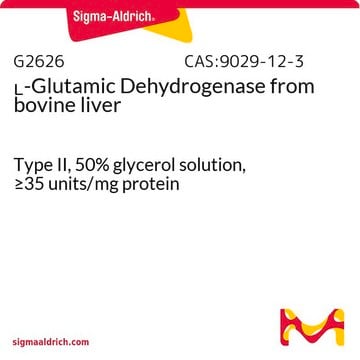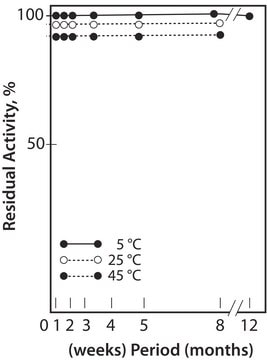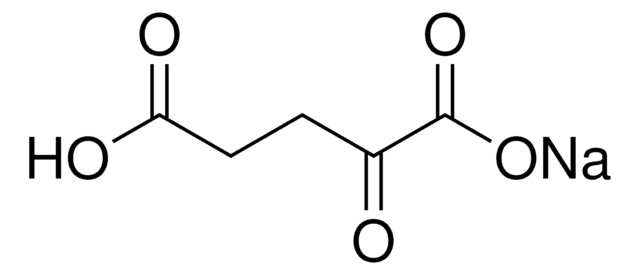G2501
L-Glutamic Dehydrogenase from bovine liver
Type I, ammonium sulfate suspension, ≥40 units/mg protein
Sinonimo/i:
L-GLDH, L-Glutamate:NAD[P]+ Oxidoreductase (deaminating), Glutamate Dehydrogenase from bovine liver
Scegli un formato
CHF 82.00
Scegli un formato
About This Item
CHF 82.00
Prodotti consigliati
Tipo
Type I
Livello qualitativo
Stato
ammonium sulfate suspension
Attività specifica
≥40 units/mg protein
PM
310-350 kDa
N° accesso UniProt
Temperatura di conservazione
2-8°C
Informazioni sul gene
cow ... GLUD1(281785)
Cerchi prodotti simili? Visita Guida al confronto tra prodotti
Azioni biochim/fisiol
The bovine enzyme is characterized by three sets of properties:
- It has a reversible concentration-dependent association, producing higher molecular weight forms.
- Forms tight enzyme-reduced coenzyme-substrate ternary complexes whose rates of dissociation modulate the steady-state reaction rates.
- Exhibits a wide variety of effects from the binding of any of a number of nucleotide modifiers.
L-glutamic dehydrogenase catalyzes the conversion of glutamate to α-ketoglutarate.
Definizione di unità
Stato fisico
Risultati analitici
Substrato
Avvertenze
Danger
Indicazioni di pericolo
Consigli di prudenza
Classi di pericolo
Resp. Sens. 1
Codice della classe di stoccaggio
11 - Combustible Solids
Classe di pericolosità dell'acqua (WGK)
WGK 3
Punto d’infiammabilità (°F)
Not applicable
Punto d’infiammabilità (°C)
Not applicable
Dispositivi di protezione individuale
Eyeshields, Gloves, type N95 (US)
Scegli una delle versioni più recenti:
Possiedi già questo prodotto?
I documenti relativi ai prodotti acquistati recentemente sono disponibili nell’Archivio dei documenti.
I clienti hanno visto anche
Articoli
Instructions for working with enzymes supplied as ammonium sulfate suspensions
Active Filters
Il team dei nostri ricercatori vanta grande esperienza in tutte le aree della ricerca quali Life Science, scienza dei materiali, sintesi chimica, cromatografia, discipline analitiche, ecc..
Contatta l'Assistenza Tecnica.











